Ethiopia is facing its worst drought since the 1980s

One of the only lasting images the West associates with Ethiopia is the famine in 1983-5 that killed more than 400,000 people, and now the country is facing another severe threat from water shortages.
The drought in the north of the country has killed livestock, many children face the risk of malnutrition, and a lack of clean water is increasing the threat of disease.
The Ethiopian government has been praised for quick action in setting aside £130m to deal with the growing crisis, but the UN says much more is needed. A joint appeal has been launched to raise an additional £923million.
The UK, already one of the largest bilateral donors in Ethiopia, has pledged to provide £30million, which will go to UN emergency food, water, and healthcare funds.
International Development Minister Nick Hurd warned that the drought was approaching the scale of the water shortage in the 1980s that killed so many.
The drought has been attributed to the El Niño effect, which this year is the strongest on record. El Niño is the name given to the effects of Pacific Ocean surface temperature rise which changes wind patterns and causes flooding, draught and affects harvests in various parts of the world.
Both the Ethiopian and UK government are urging that steps are taken to both tackle climate change and increase long-term food security to mediate the effects of future droughts.














































